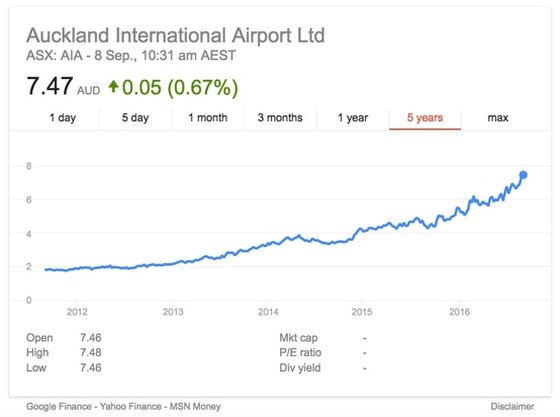Auckland International Airport Ltd (AIA.AX) remains a solid defensive yield stock that is performing very strongly with traffic growth at multi year highs, helping to drive other areas of the business. Industry dynamics continue to be very positive for airports with the real cost of travel declining while disposable income and propensity to travel continue to increase, particularly in emerging economies.
Management seems very confident in the outlook for the business with traffic growth strong, the Auckland property market in an upswing, retail benefitting from the new duty free operators and revenue to step up over coming periods from the delivery of additional retail space and areas like car parking also seeing solid growth. Risks still exist around the pricing reset in 18 months’ time but management still seems comfortable that they have levers to pull to maintain an inflation level increase in aero-charges.
Our valuation (based on a blend of discounted cash flows (DCF) and multiples) and target price increases to NZ$7.03 (from NZ$5.92) reflecting a roll forward of the valuation and updated growth assumptions. This trails the current share price of NZ$7.68 and implies a -6% total shareholder return (TSR). Average 12 month forward broker valuation is NZ$6.12 (range from NZ$5.00-7.95). The street generally can’t get its head around the currently priced valuation on AIA and we are struggling too.
Trading on 22.8x FY17F EV/EBITDA (vs an historical average 14.5x, 18.8x 2-year average) and a 2.6% yield (vs 3.6%, 3.2%), AIA looks fully valued at current levels.
Auckland Airport is a quality asset that is well held internationally and is an important part of the NZ index. Given the quality of the business and solid outlook, we don’t see a significant catalyst for a derating in the short term (aero pricing outcome is the biggest issue) and we expect it to continue to trade at elevated multiples (especially with the NZ Reserve in a rate cut cycle). We also note that Sydney Airport Holdings Ltd (SYD.AX) is trading well ahead of historical multiples. However, interest rates are closer to the bottom and we are arguably starting to see a cyclical shift as the US moves to increase rates and further interest rate cuts are being seen as being more detrimental than beneficial.
Happy Investing,


